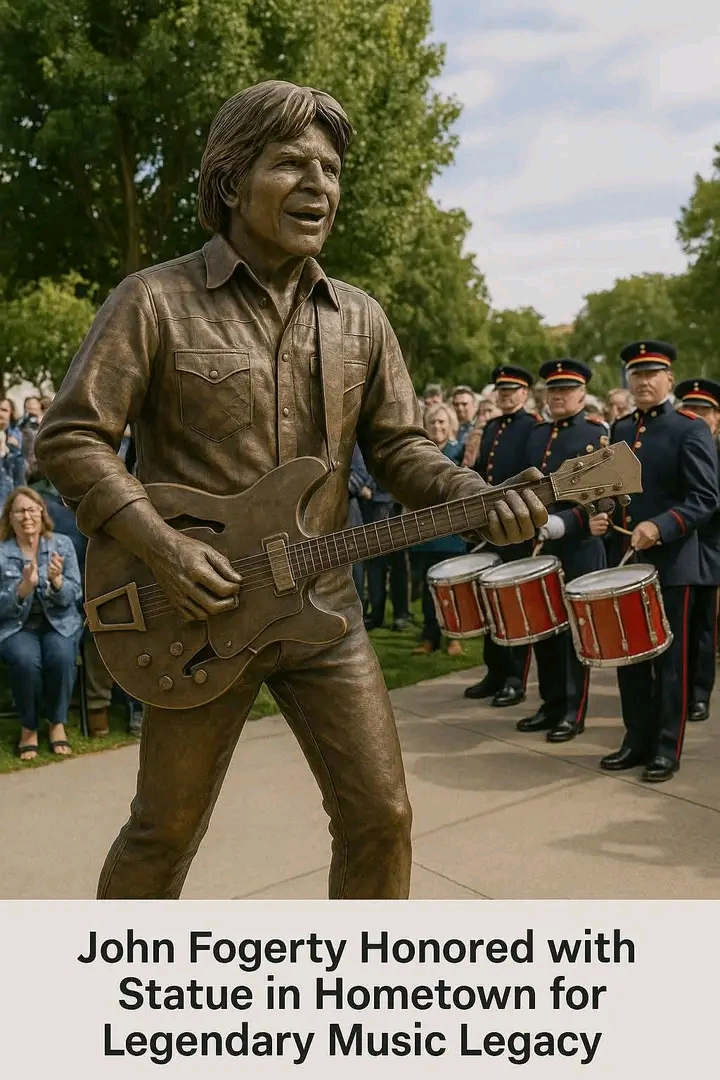
In a touching tribute to one of rock and roll’s most iconic voices, John Fogerty, the frontman of Creedence Clearwater Revival, has been immortalized with a statue in his hometown. The bronze monument, which captures Fogerty mid-performance with his guitar, was unveiled during a heartfelt ceremony attended by fans, local officials, and members of the music community. For many, it was a long-overdue recognition of a man whose voice and songwriting defined a generation.
The statue stands in Berkeley, California, a place where Fogerty spent his formative years and began his legendary career. Though Creedence Clearwater Revival was often associated with the sounds of the American South, their roots were firmly planted in California, where their journey from garage band to global sensation began. Locals see the statue not only as a tribute to Fogerty but also as a symbol of the rich musical legacy that originated in the area.
The unveiling ceremony was an emotional affair. Fogerty himself attended, visibly moved as he addressed the crowd. In his speech, he thanked the community for their support throughout his career and expressed his gratitude for being honored in the place where it all began. He recalled the early days of rehearsals, playing at local venues, and the community that rallied around him and his bandmates.
Fans from across the country gathered for the event, some traveling thousands of miles just to witness the special moment. For them, Fogerty’s music is more than entertainment—it’s the soundtrack to their lives. Songs like “Bad Moon Rising,” “Fortunate Son,” and “Have You Ever Seen the Rain?” have become timeless anthems that continue to resonate across generations.
Local musicians performed CCR classics during the event, filling the streets with the familiar sounds that made the band famous. It was a celebration not only of Fogerty’s past but of his continued influence on the world of music. Artists and fans alike acknowledged the role he played in shaping American rock and inspiring countless performers.
The statue itself was created by renowned sculptor David A. Castillo, known for his lifelike work honoring musical legends. The piece depicts Fogerty in a powerful pose, guitar slung over his shoulder, mouth open in mid-song. Castillo stated that capturing the intensity and passion of Fogerty’s performances was his guiding mission throughout the sculpting process.
For the city of Berkeley, the statue is more than public art; it’s a landmark. City officials shared plans to designate the area around the statue as “Fogerty Plaza,” complete with plaques detailing his contributions to music history and his ties to the community. It’s a move that cements Fogerty’s place not only in rock and roll lore but also in the heart of the city that helped raise him.
This tribute is part of a larger wave of recognition for classic rock icons who laid the foundation for modern music. While many of Fogerty’s contemporaries have received honors and accolades, this statue marks a tangible, lasting celebration of his achievements and enduring popularity. It reflects a cultural shift toward honoring living legends while they can still feel the appreciation.
Fogerty’s legacy extends far beyond his work with Creedence Clearwater Revival. His solo career, advocacy for artists’ rights, and recent performances with his children have kept him in the public eye and earned him continued respect. The statue captures not just who he was, but who he still is—a powerful force in music and a humble steward of his own history.
The statue was officially unveiled on May 24, 2025, a date now etched in local history as a celebration of both artistic achievement and community pride. Fogerty shared that seeing the statue for the first time was “surreal and deeply humbling,” and thanked the sculptor and the city for the honor.
Since the unveiling, fans have flocked to the site, leaving flowers, handwritten notes, and CCR memorabilia at the base of the statue. It’s quickly become a pilgrimage point for music lovers, further underscoring the deep emotional connection people feel toward Fogerty and his music. The city is already seeing a rise in tourism centered around the site.
In a time when so much in music is fleeting, the statue stands as a reminder of the enduring power of authenticity, grit, and soul. John Fogerty may have sung about the bayou, but his roots are in Berkeley—and now, thanks to this statue, those roots will never be forgotten.


